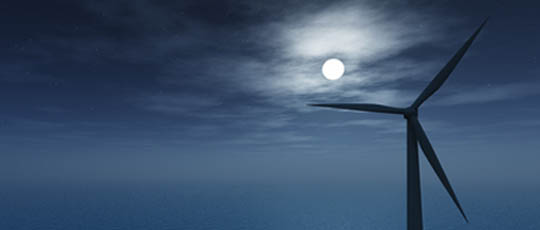



A wind generator, also known as a wind turbine, converts kinetic wind energy into electrical energy. Wind generators have a number of components, including blades, a shaft, a generator and a tower. The blades look like propellers, and are designed to catch the wind. The shaft is connected to the blades which rotate as they turn with the wind. The shaft runs into the generator which transforms the rotations of the shaft mechanical energy into electrical energy. All of these components are mounted on a tower to position the wind generator for higher wind speeds and to generate wind power.
In a normal residential wind power application, the wind generator and a local utility serve a home simultaneously. If the wind speeds are below cut-in speed (7 - 10 mph) there will be no output from the generator and all the needed power is purchased from the utility. As the wind speeds increase, generator output increases and the amount of power purchased from the utility is proportionately decreased. When the wind generator produces more power than the house needs, the extra electricity is sold to the utility. All this is done automatically. There are no batteries in a modern residential wind system.
A home wind generator typically lowers your electric bill by 50 - 90 percent. It is not uncommon for wind generator owners with total-electric homes to have monthly utility bills of $8 to $15 for nine months of the year. In northern parts of the country where less air conditioning is used, the bills can be very low year-round. The amount of money a small wind generator saves you in the long run will depend on its cost, the amount of electricity you use, and the average wind speed at your site.
A residential wind turbine can be a relatively large device and is not suitable for urban or small-lot suburban homes Except for very small wind turbines (i.e., with rotors one meter or less in diameter) on very small towers, a property size of one acre or more is desirable. It is best to have at least a 10 mph average wind speed and be paying at least 10 cents/kWh for electricity. Residential wind generators have been installed in at least 47 of the 50 states, but the majority of the units have been installed in the Northeast and the Midwest.
Yes. Wind turbine generators produce no pollution and by using wind power you will be offsetting pollution that would have been generated by your utility company. Over its life, a small residential wind generator can offset approximately 1.2 tons of air pollutants and 200 tons of greenhouse gases.
Small wind generators do make some noise, but not enough to be found objectionable by most people. A typical residential wind system makes less noise than the average washing machine. Wind generators do not interfere with TV reception. In addition, a newer style of vertical axis wind generators is becoming popular because of their unique design and almost silent operation.
No. A wind generator is easily retrofitted to virtually any home without the need to change any wiring or appliances. In most cases, the utility will install a second utility meter to measure how much surplus electricity it is purchasing from the generator owner.
A small wind generator can cost anywhere from $6,000 to $22,000 installed, depending upon the size, application and service agreements with the manufacturer.
Most small wind generators have very few moving parts and do not require any regular maintenance. They are designed for a long life (up to 20 years) and operate completely automatically.
A wind generator system will usually recoup its investment through utility savings within six - to fifteen years and after that the electricity it produces will be virtually free. Over the long term, a wind generator is a good investment because a well-sited wind system increases property value, similar to any other home improvement.
Tags: wind generators, wind power generators, home wind generator, free wind generator plans, build wind generator, build your own wind generator, vertical wind generators, homemade wind generator, home wind generators, wind power generator, wind powered generators, vertical axis wind generator, wind turbine generator, verticle wind generator
Source: American Wind Energy Association - Wind Generator Basics
877-331-1235 | © Copyright DASolar.com.